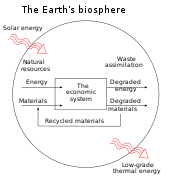Wealth, Virtual Wealth and Debt
Organizations: Wealth, Virtual Wealth and Debt is a 1926 book by the Nobel Prize–winning chemist Frederick Soddy on monetary policy and society and the role of energy in economic systems.
Soddy criticized the focus on monetary flows in economics, arguing that real wealth was derived from the use of energy to transform materials into physical goods and services.
[2] In this book Soddy points out the fundamental difference between real wealth (consumables such as buildings, equipment, energy, food) and virtual wealth, in the form of money and debt.
Soddy contends that real wealth is subject to entropy and will rot, rust, wear out, or be consumed over time, while money and debt (as artificial accounting devices) are subject only to the laws of mathematics, not the laws of thermodynamics.
Soddy uses actual occurring examples to demonstrate what he considers a major flaw of prevailing economic theory.
